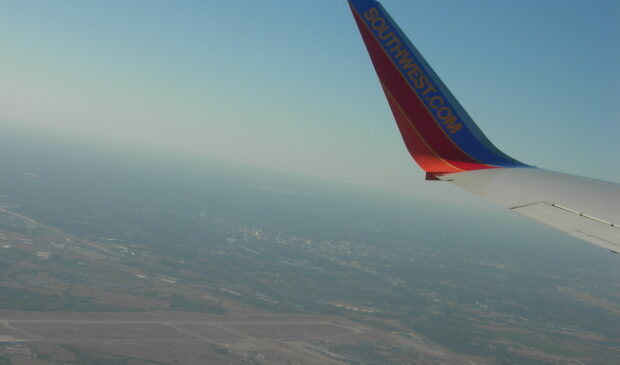Austin near-miss incident subject of discussion at U.S. Senate hearing on nationwide airport safety “crisis”
Tuesday, November 14, 2023 by
Nina Hernandez February’s near-miss incident at the Austin-Bergstrom International Airport was the subject of discussion at a U.S. Senate subcommittee hearing last week on nationwide airport safety concerns.
Aviation industry executives and government officials testified on how to improve safety at the U.S. Senate Committee on Commerce, Science, and Transportation Subcommittee on Aviation Safety, Operations, and Innovation hearing on Nov. 9.
“The near misses we’ve been seeing recently are not normal and are a warning our aviation system is under stress,” said Sen. Tammy Duckworth (D-Illinois), who is a pilot. “Our nation is experiencing an aviation safety crisis. Near misses are happening way too frequently, and I refuse to be complacent in waiting to act until the next runway incursion becomes a fatal collision.”
Duckworth said that a wave of retirements in the air traffic control profession coupled with record travel demand resulted in safety margins falling to “dangerously thin” levels. She referenced a New York Times report that details the February incident between a FedEx cargo plane and a Southwest Airlines flight cleared to use the same runway. The Times article called Austin a “microcosm” of a nationwide staffing issue with air traffic control that has resulted in hundreds of such incidents.
“In far too many near misses, the difference between a close call and a deadly disaster has depended on a single individual taking emergency action along with some good luck,” Duckworth said.
Duckworth detailed a runway incursion at Boston Logan International Airport. Air traffic control averted disaster in the incident with the help of a surface safety system, which notified air traffic control that a charter flight had begun an unauthorized takeoff.
“This layer of safety was critical in empowering the controller to provide JetBlue with the go-round instructions that diverted disaster,” Duckworth said. “Unfortunately, that very same month at Austin-Bergstrom International Airport, we witnessed how the lack of critical surface detection equipment drastically increases the risk of catastrophe. Words fail to adequately describe how close 131 souls came to dying that day.”
Duckworth also called for Congress to bolster the air traffic control system, which is currently facing staffing and morale crises. Sens. Jerry Moran (R-Kansas) and Maria Cantwell (D-Washington) called for passage of the Federal Aviation Administration reauthorization bill, which includes increased air traffic control staffing.
Jennifer Homendy, chair of the National Transportation Safety Board, the entity responsible for investigating civil transportation accidents, testified before the subcommittee. The NTSB launched investigations into seven runway incursions this year, and in half of those incidents the aircraft came within 100 feet of each other. Homendy said that under her leadership, which began in the summer of 2021, the NTSB has eliminated its backlog of investigations, increased staffing and invested in IT.
In addition to hosting a series of safety summits, Timothy Arel, FAA air traffic organization chief operating officer, told the subcommittee that the administration is currently “fast tracking” new technologies to address specific safety concerns and are deploying service awareness technology to airports that currently don’t have it.
“We are optimistic that our ongoing work, in collaboration with industry and labor, will continue to lead to greater safety improvements,” Arel said. “The FAA will continue to be vigilant and continue collaborating with everyone that utilizes the national airspace system to enhance safety with the goal of eliminating significant safety events. Going forward, zero has to be the only acceptable number.”
Austin’s own public officials continue to raise the alarm. In June, former Austin Airport Advisory Commission Chair Eugene Sepulveda told the Austin Monitor that his questions earlier in the year to airport staff regarding whether ABIA’s safety protocols were keeping pace with traffic had gone unanswered. He said the city should independently confirm the adequacy of those protocols.
In October, U.S. Rep. Lloyd Doggett urged action to address the issue at the national level, including the expanded staffing, training and priority consideration for Austin’s airport in future rounds of transfers facilitated by the National Centralized Employee Requested Reassignment Process Team.
U.S. Rep. Greg Casar echoed those calls in an open letter to the FAA administrator last week. The letter asks the FAA what it will do to improve the current completion rate for trainees, how a potential government shutdown would impact this year’s hiring goals and to guarantee Austin-area air traffic control applicants that they can work at the Austin airport.
“As air travel continues to increase, it is imperative that the FAA address these dangerous shortages. I look forward to your prompt response as I continue to monitor this situation closely,” Casar wrote.
Photo made available through a Creative Commons license.
The Austin Monitor’s work is made possible by donations from the community. Though our reporting covers donors from time to time, we are careful to keep business and editorial efforts separate while maintaining transparency. A complete list of donors is available here, and our code of ethics is explained here.
You're a community leader
And we’re honored you look to us for serious, in-depth news. You know a strong community needs local and dedicated watchdog reporting. We’re here for you and that won’t change. Now will you take the powerful next step and support our nonprofit news organization?







